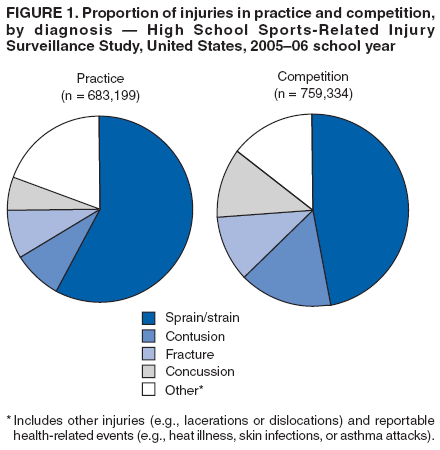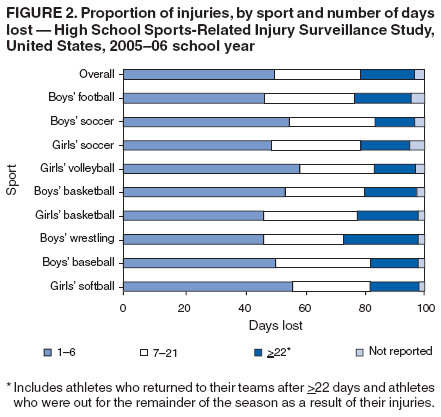Injury incidence in soccer, how to treat injuries and different ways doctors might treat you
The goal of soccer training is improved performance, injury prevention, soccer skills and tactics. Improved performance should never come at the cost of an injured player. Goal #1 is injury prevention in a soccer conditioning program. Goal #2 is to improve performance.
Soccer performance training is about far more than increased
performance. I know I know, you donít have to say it. Everyone wants to
be the fastest, quickest, and score the most goals . But how can you do
that if you are not on the field. Donít worry, you can accomplish both
injury prevention and performance improvement in the same program.
Some injuries are freak accidents while others occur because of poor
training habits. Stopping injuries all together may be impossible. Our
goal will be to reduce the incidence of injury. In part one of this
three part series we will talk about the different types of injuries and
what to do if you get injured.
There is always some risk involved when playing sports. Injuries are
negative side of playing, but we still do it because we love the sport.
As shown by a study sponsored by the CDC the overall injury rate of all
sports together was 2.44 per 1000 athlete exposures (An exposure is
defined as a single athlete participating in a single practice or
competition during which the athlete was exposed to a chance of athletic
injury.) It may be of no surprise that American football had the highest
injury rate (4.36 per 1000 exposures) followed by wrestling (2.5), then
boys soccer (2.43) and girlsí soccer (2.36). (3)
An interesting facet of this study is about 80% of the reported injuries
were new occurrences rather than recurrences. (3)
If we break down the major occurences of injuries amoung high school age
athletes we find that strains and sprains are by far the worst (Figure
1) (3)

An unfortunate aspect of injury is missing games. The most frequent timeline for days missed due to injury is 1-6, followed by 7-21 days, and finally greater than 22 days. Figure 2 (3) shows the number of days missed for soccer players due to injury. (3)

Is there a difference between acute and chronic injury? If so what are they?
Acute injuries occur suddenly when playing or practicing. ACL tears, sprained or fractured ankles are all examples of acute injury. The signs of acute injury include: (2)
-
Sudden,severe pain
-
Swelling
-
Not being able to place weight on a leg, knee, ankle or foot
-
Not being able to move a joint as normal
-
Extreme leg or arm weakness
-
A bone or joint that is visible out of place (2)
Chronic Injuries happen after you after you play a sport or exercise for a long time. Signs of chronic injury include: (2)
-
Pain when you play or practice
-
A dull ache when you rest
-
Swelling (2)
Can you reduce the incidence of Acute injury?
The answer to this is yes. I know acute injuries seem to be freak accidents that occur on the somewhat less fortunate athlete. To a certain degree this is true, but not entirely. Through a proper training program soccer athletes can reduce even acute injuries. I will not go into it now because parts 2 and 3 discuss how to reduce injury.
What should you do if you get injured? (2)
Never try to
work through the pain. Stop playing when you feel pain.
(2)
You should call a doctor when:
-
The injury causes severe pain, swelling or numbness
-
You canít put any weight on the area
-
An old injury swells
-
The joint doesnít feel normal or feels unstable (2)
How might a doctor treat an injury? (2)
Nonsteroidal Anti inflammatory drugs (2)
Sometimes a doctor will suggest drugs such as asprin or ibuprofen. These
drugs reduce swelling and pain.
Immobilization (2)
This prevents further injury and damage. Slings, casts and splints are
used to immobilize sports injuries
Surgery (2)
The dreaded surgery! In some cases it is needed to fix sports injuries.
They can fix torn tendons and put back broken bones.
Rehab (2)
This is a key part of treatment. Many times this will involve a
qualified physical therapist who has years of training and education
leading you step by step back to the point of full sport involvement.
As injury heals, scar tissue forms. After a while, the scar tissue
shrinks. The shrinking brings the injured tissues back together. In this
case, the injured area becomes tight or stiff. This is when you are at
your greatest risk of injuring the area again.
Why is RICE good for injury, I thought you eat it?
We'll you are correct. Rice is a food but RICE is not. RICE is an acronym for Rest, Ice Compression and Elevation. Rice is a methodology used for treating yourself for injury ,when appropriate.
How do I use RICE not Rice for injury?
REST
Reduce regular activities. If youíve injured your foot, ankle or knee take the weight off. Sometimes a crutch may be beneficial. (3)
ICE
Ice the injured area for 20 minutes, four to eight times a day. A cold pack or ice bag will also work. You can also benefit from using a bag filled with crushed ice wrapped in a towel. After 20 minutes remove the ice. (3)
Compression
Put even pressure on the injured area to reduce swelling. An elastic wrap, special boot, air cast may work as well. (3)
Elevation
Elevate the injured area at a level above your heart. You might consider
resting the injured area a pillow or something else soft.
In this article we've examined different aspects of injuries and treating them. This information should only be used as educational. In no case should this article take the place of a qualified healthcare professional. In parts two and three of this series we will discuss how to reduce injuries generally and specifically in the Knee. (3)
Injury Prevention Links:
Reference
2. NIAMS
3. CDC
